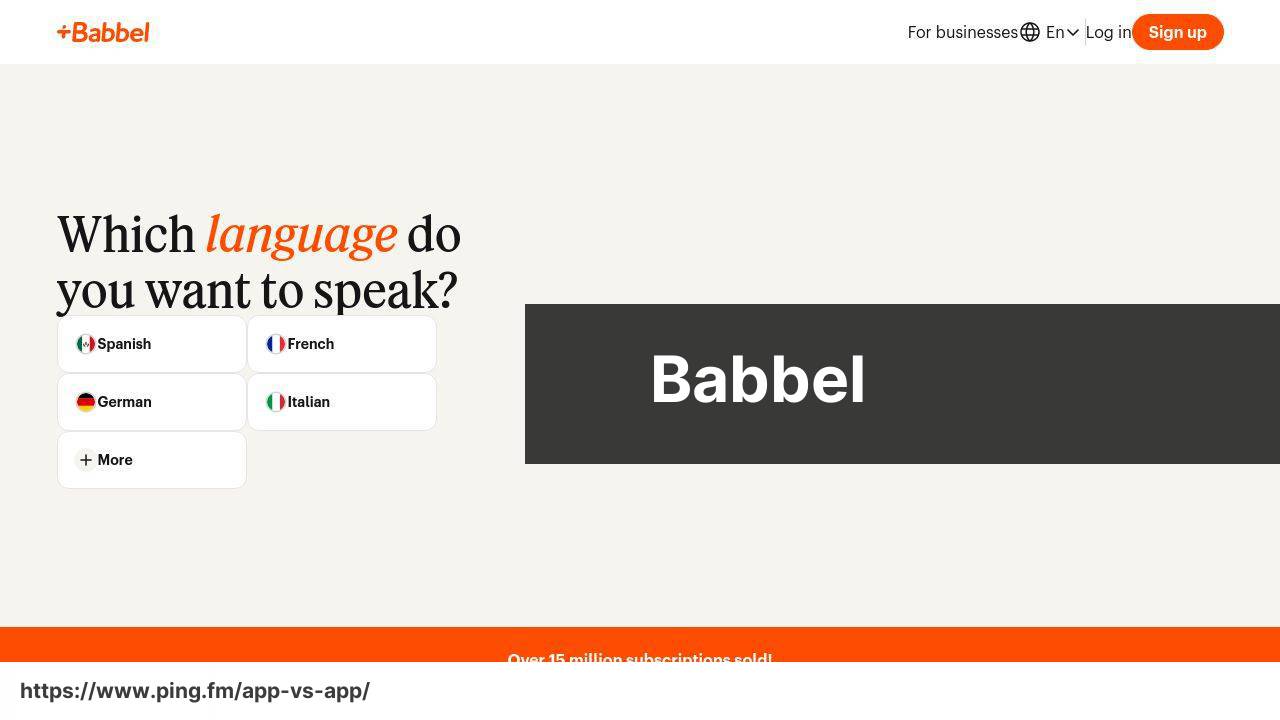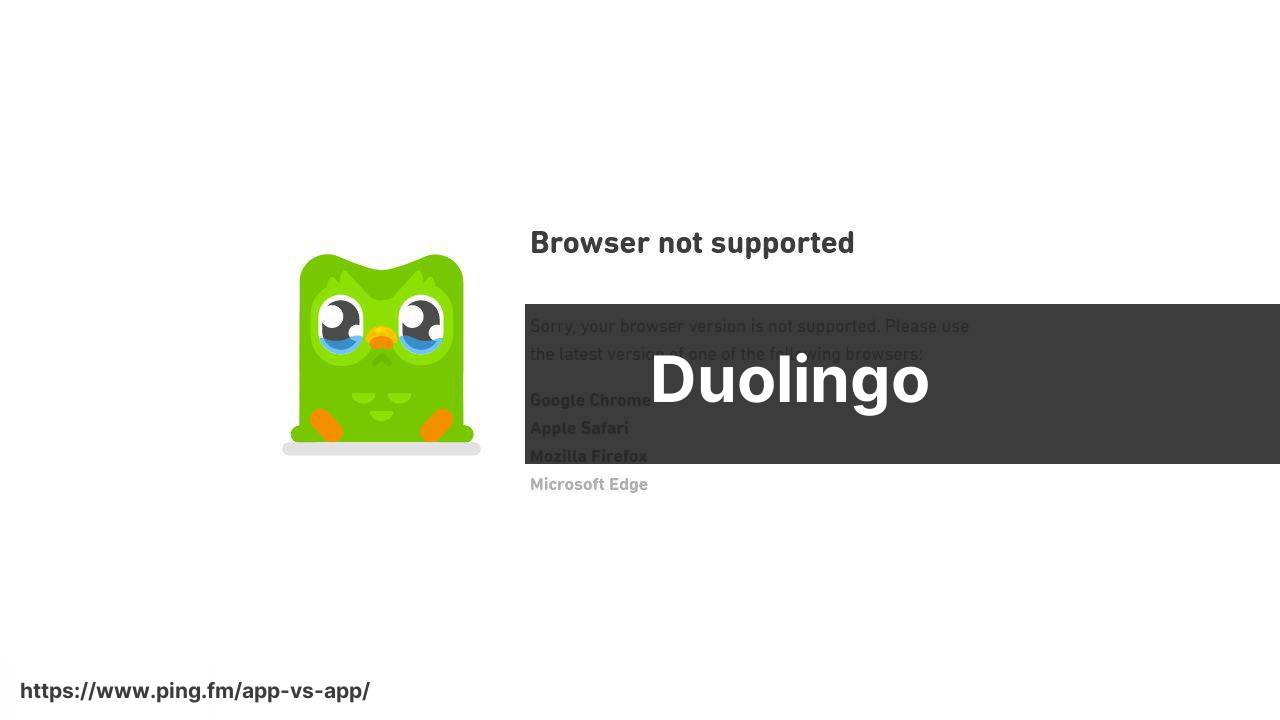Last update on
Duolingo vs Babbel (best free language learning apps / software)
Compare | Winner | |
| Number of Languages | ||
| Teaching Method | ||
| User Interface | ||
| Pricing | ||
| Additional Tools | ||
| Mobile App | ||
| Social Interaction | ||
| Offline Access | ||
| Business Language Learning | ||
| Customer Support | ||
| FREE / PAID | Babbel isn’t free. It offers a subscription model that costs $12.95 per month. More affordable plans available for long-term commitments. | Duolingo is free to use but it monetizes through Duolingo Plus – a subscription that costs $6.99 per month, offering ad-free learning and some additional features. |
| Conclusion | Babbel offers in-depth courses in 14 languages, it’s not free but offers richer content for serious learners. 👌🏼⏰💵 | Duolingo offers a fun, game-like approach to learning 30+ languages. 🎮🌐 It’s completely free but has premium subscription for ad-free experience. 🆓📚 |
Babbel Pros & Cons
🎯Focused lessons
🗣️Conversational practice
🏫In-depth courses
⏰Flexible learning time
📝Grammar explanations
Duolingo Pros & Cons
💬Wide range languages
🎮Game-like lessons
👐Interactive exercises
🎯Personalized learning
📱Great mobile app
💰Free to use
💰No free version
🌍Fewer languages
👥Limited social interaction
📱App could be better
💼No business language learning
🎧Limited pronunciation help
👨🎓Not for advanced learners
🗣️Less focus on speaking
💼Lacks business language learning
💰Ads in free version
🌐Limited offline access
Other best free language learning apps
Rosetta Stone is a software-based language learning system which offers 24 languages. 👥💻 It’s a bit pricey but provides quality content. 💰👍
Memrise is great for visual learning of 16 languages. 🎨👁️ It has both free version and Pro subscriptions. 👏💸
Busuu offers 12 languages with a strong community for language practice. 🌍🗣️ It has limited free access with premium subscriptions. 👍💲
FAQ
What are some of the best free apps to learn languages?
Some of the best free language learning apps include Duolingo, Babbel, Memrise, Rosetta Stone, and Busuu. These platforms provide comprehensive language learning tools, lessons, and practice exercises for a variety of languages.
How does the learning process work on Duolingo?
On Duolingo, learners start by choosing their target language and setting a daily goal. The learning process primarily consists of a series of short, game-like exercises where learners gradually learn the vocabulary, grammar, and sentence structure of a new language. Users are rewarded with points for correct answers and encouraged to maintain a daily streak.
Can one learn multiple languages simultaneously on Duolingo?
Yes, users on Duolingo can opt to learn multiple languages simultaneously. Each individual language course operates independently, allowing learners to switch between their chosen languages whenever they wish.
Is Babbel free?
While Babbel does offer a free trial for new users, it is primarily a paid app. The cost ranges depending on the chosen subscription length, with long-term subscriptions offering more significant savings.
How does Babbel differ from Duolingo?
Both Babbel and Duolingo provide high-quality language learning resources. However, while Duolingo offers a completely free service, Babbel is subscription-based. Additionally, Babbel’s curriculum is more structured, making it ideal for users seeking a more traditional learning approach.
Does Duolingo offer certification?
Yes, Duolingo offers a Duolingo English Test that is accepted by various universities worldwide as proof of English proficiency.
Are there any social features on Duolingo?
Indeed, Duolingo has social aspects. Users can connect with friends for added motivation, join a club with other learners, or participate in leaderboards to compete against other users worldwide.
What languages can one learn on Babbel?
Currently, Babbel offers courses in 14 languages, including Spanish, French, Italian, German, Portuguese, Swedish, Turkish, Dutch, Polish, Indonesian, Russian, Danish, Norwegian, and English.
Does Babbel have a companion desktop platform?
Yes, alongside its mobile application, Babbel also offers a desktop platform. This allows learners to continue their lessons seamlessly, regardless of the device they are using.
How does the Babbel teaching methodology work?
Babbel employs a teaching method that emphasizes conversational language skills. Lessons are designed around practical, everyday situations, enabling learners to start speaking a new language quickly. Grammar and vocabulary are taught within the context of authentic dialogues.
Does Babbel have testing or levels?
Yes, Babbel offers tests at the end of each course to assess learners’ progress. Learners can also choose their level of proficiency when starting a new language, ensuring that the lessons are appropriate for their knowledge level.
Can I download Duolingo lessons for offline learning?
Yes, you can. Duolingo allows users to download lessons for offline use. This is particularly handy for learners who wish to study when internet access is not available.
How does Duolingo make language learning fun?
Duolingo uses gamification to make language learning fun and engaging. The app rewards learners with virtual coins, unlocks new levels upon progress, and allows competition with friends to maintain motivation.
What free trial options does Babbel offer?
Babbel offers a free trial that gives the learner access to one course in the language of their choice. After this, a subscription is necessary to continue access to all courses and features.
Does Babbel offer a language proficiency test?
While Babbel doesn’t provide a formal language proficiency test, it offers review sessions and quizzes throughout the courses that help learners track their progress and understand their proficiency levels.
What age group is Duolingo best suited for?
Duolingo is versatile and user-friendly, making it suitable for a broad age range, including children, teenagers, adults, and seniors. However, there is also a Duolingo Kids application specifically designed for children under the age of 12.
How many people use Duolingo?
As of 2021, Duolingo boasts a community of over 300 million users worldwide, confirming its popularity as a top free language learning app.
Will Duolingo help me become fluent?
While Duolingo is an excellent resource for getting started with a new language or strengthening existing language skills, achieving fluency requires more immersion and interaction than the app provides by itself. However, Duolingo can be a critical tool in a broader learning plan that includes conversation practice, reading, and cultural immersion.
Can I progress at my own pace on Babbel?
Absolutely. On Babbel, learners progress at their own pace. The system saves the learner’s progress automatically, allowing them to pick up where they left off whenever they log in next.
Will Babbel make me fluent in a new language?
Like any language learning tool, Babbel’s effectiveness highly depends on the user’s commitment. While it provides the resources for beginners to understand and communicate basic concepts, achieving fluency may require additional methods, such as immersion and real-world conversation practices.
Which are some of the best free language learning apps available today?
Some of the best free language learning applications include Duolingo, Babbel, Rosetta Stone, HelloTalk, and Memrise, among others.
What makes Duolingo a popular language learning app?
Duolingo is popular because it uses a gamified approach to make language learning fun. Besides, it offers various languages for free which makes it an affordable choice for many learners.
Is Babbel a free language learning app?
Though Babbel offers some free content, it primarily operates on a subscription-based model. It gives you a free trial period after which you need to purchase a subscription to access its full content.
Can I learn multiple languages at a time on Duolingo?
Yes, Duolingo allows you to learn multiple languages simultaneously. Each of your chosen languages will have a separate learning path.
Do I need to be online to use Babbel?
No, you don’t need to be constantly online. Babbel provides the option to download lessons for offline use which comes in handy during travel or when you don’t have access to the internet.
How does Duolingo structure its lessons?
Duolingo structures its lessons into themed blocks, where each block focuses on specific language skills or vocabulary sets. It gradually increases difficulty to ensure continous learner’s progress.
What teaching method does Babbel use in its lessons?
Babbel uses a conversational method of teaching, concentrating on real-life scenarios. It includes interactive dialogues, grammar lessons, and vocabulary practice with a focus on pronunciation.
What skills does Duolingo focus on during language learning?
Duolingo focuses on improving reading, writing, listening, and speaking skills in the target language. The app’s varied exercise formats help to strengthen all these areas.
What languages can I learn using Duolingo?
You can learn more than 30 languages using Duolingo including Spanish, French, German, Italian, Dutch, Russian, Japanese, and even Esperanto.
How many languages does Babbel offer for learning?
Babbel offers 14 languages which include Spanish, French, German, Italian, Portuguese, Swedish, Turkish, Dutch, Polish, Indonesian, Norwegian, Danish, Russian, and English.
How often do I need to practice on Duolingo?
For optimal results, Duolingo recommends daily practice. The app encourages learning by streak count, which motivates learners to use the app consistently.
Does Babbel provide certificates after course completion?
Yes, upon successfully completing a course, Babbel provides a certificate of completion which you can include in your resume or LinkedIn profile.
Can Duolingo be used by kids for language learning?
Duolingo can be an excellent tool for kids due to its gamified structure that makes learning fun. However, parental supervision is always recommended while the child is interacting with the app.
Does Babbel offer courses for business professionals?
Yes, Babbel offers a variety of specialization language courses designed specifically for business professionals to develop proficient communication skills in foreign languages.
What are the limitations of using free language learning apps like Duolingo?
While free language learning apps like Duolingo are a great starting point, they may lack depth in explaining grammatical structures and cultural nuances. They might also not provide enough conversation practice necessary for language fluency.
Does Babbel have any collaborations with educational institutions?
Yes, Babbel has partnerships with several universities and schools around the world as part of its Babbel for Education program. These institutions use Babbel’s courses as part of their curriculum to aid language learning.
Does Duolingo offer any certifications for language proficiency?
Duolingo offers a Duolingo English Test as a certified proof for English proficiency, which is accepted by thousands of universities worldwide.
What are the subscription plans for Babbel?
Babbel offers various subscription plans ranging from a one-month to a one-year subscription. The price per month decreases with the length of the subscription plan.
Is it possible to switch languages halfway through a course on Duolingo?
Yes, you can switch between languages at any time in Duolingo. However, it’s generally recommended to grasp the basics of one language before moving on to another for effective learning.
What kind of support does Babbel offer to its users?
Babbel offers comprehensive customer support, which includes a help center that answers common questions, email support, and active social media channels for updates and assistance.
 ping.fm
ping.fm 

